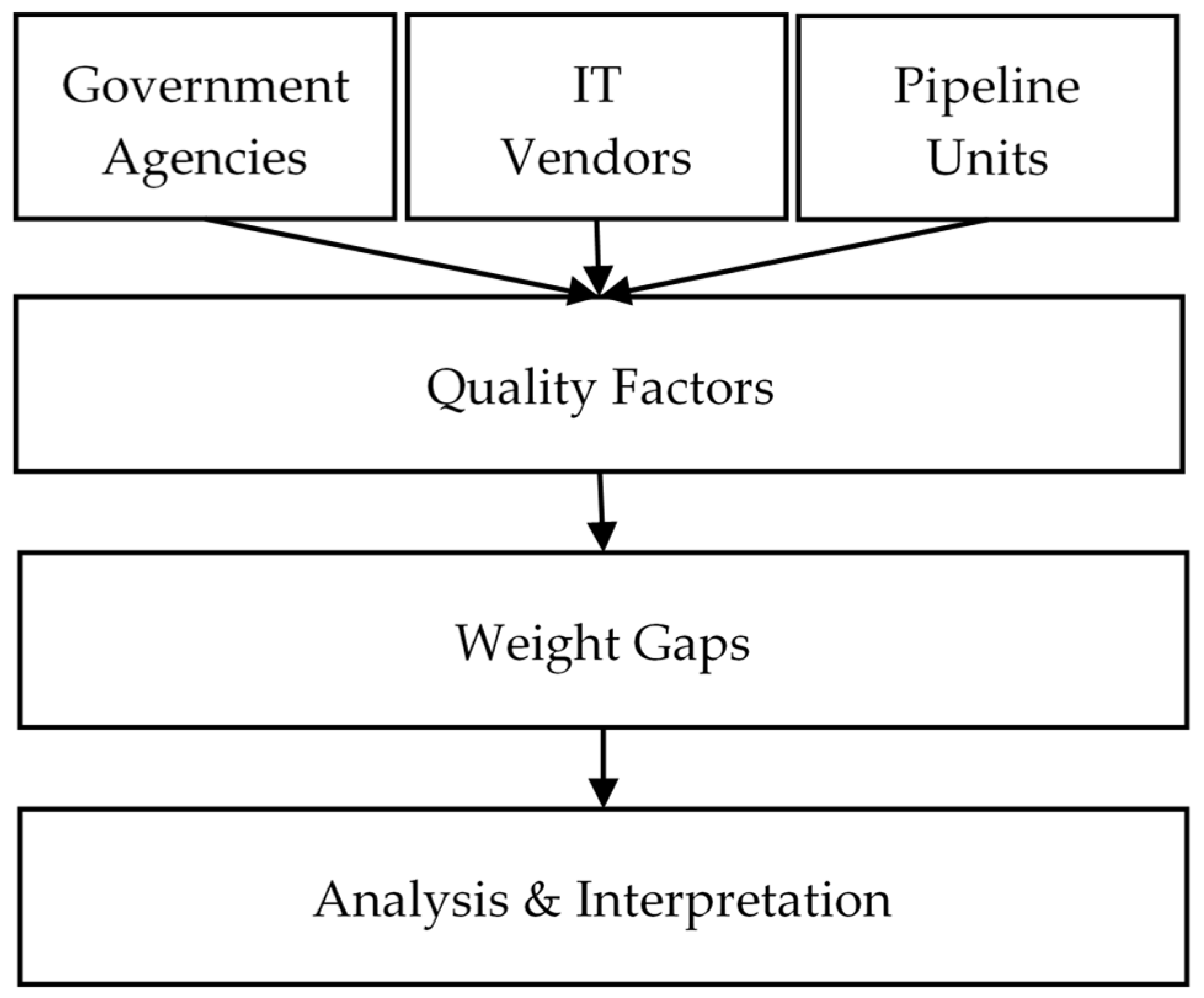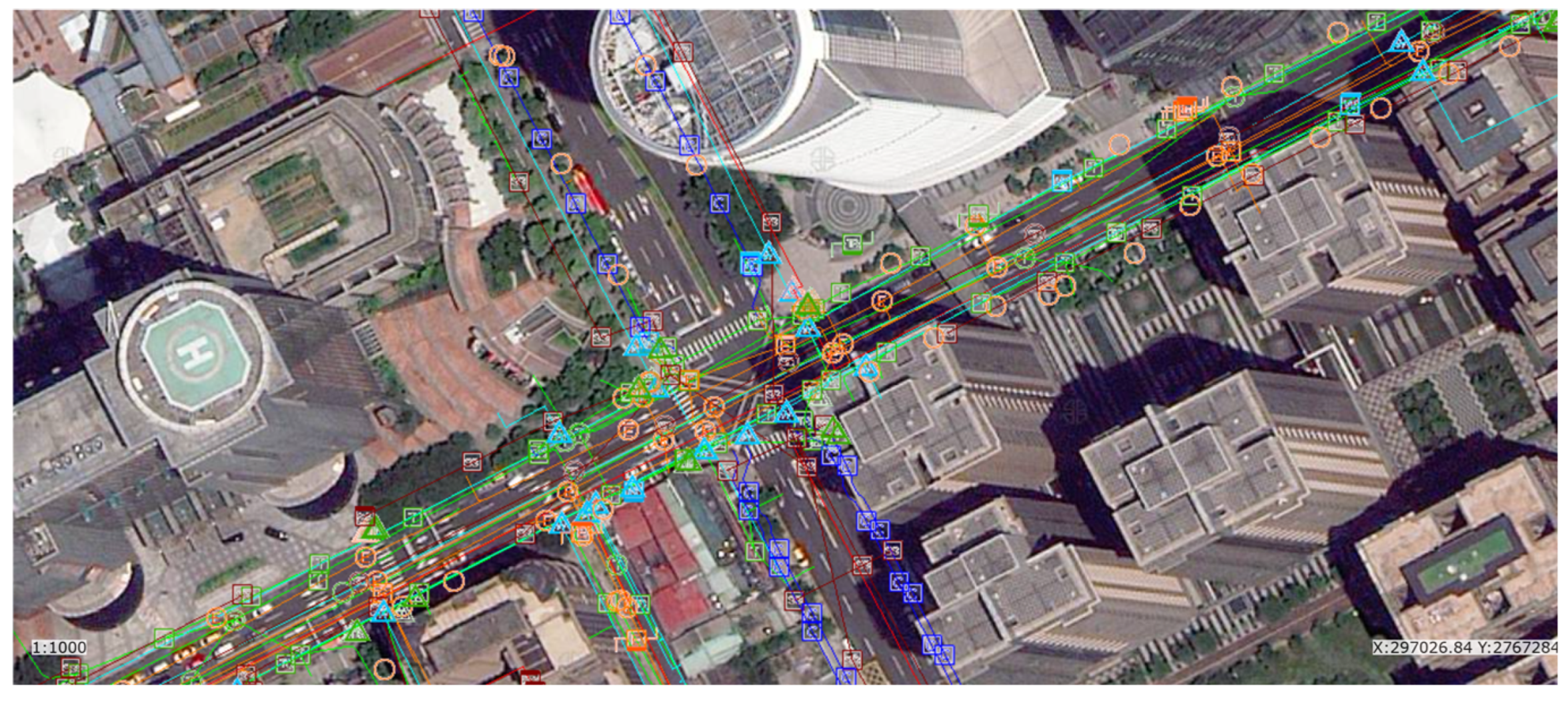1. Introduction
The government is supposed to introduce quasi-market mechanisms to provide public services centered on quality [
1]. In other words, the government must provide citizens with appropriate public services. Farnham and Horton [
2] proposed the concept of New Public Management by suggesting that the government must be responsive to the citizen. This means that government information systems must serve to provide rapid responses to citizens’ needs. Opposite to the conventional government depending mostly on face-to-face services, an e-government, benefitting both from the rise of the Internet and the construction of government information systems, is geared toward information services more quickly and efficiently provided for government transparency and accountability [
3,
4].
Satisfaction is crucial for government information systems [
5,
6]. According to a 2023 satisfaction survey of the Road Excavation Management Information System in X city in Taiwan, the proportion of those who were dissatisfied and felt a lack of systematical enhancement reached 20.81%. In this case, the reason and aspects must be explored. Therefore, we investigated factors affecting the satisfaction with government information systems from different perspectives (government agency authorities, IT vendors, and pipeline units). Based on the results, explanations and suggestions are provided.
2. Literature Review
DeLone and McLean [
7] proposed the success model of information systems and suggested that the success of an information system must be examined from two perspectives: information quality and system quality. System quality refers to the measurement of technological success, while information quality measures semantic success. That is, the quality of the information is determined by the information system. System and information qualities influence the information system and user satisfaction. In using the information system, the users evaluate their satisfaction. Individual impact is classified into the understanding of information and the degree of information application. Individual impact is assessed using financial indicators and benefit evaluations.
Many countries have transformed service-oriented economic entities to service industries. DeLone and McLean [
8] enhanced the initial information system success model by using the concept of service quality, defined as the support provided by the service provider (an IT department, a new organizational unit, or an outsourced contractor). So far, three key quality factors of the IS Success Model have been determined: system quality, information quality, and service quality. In this model, the use of the information system is differentiated depending on usage behavior.
Information system success models are applied to government information systems. Unlike commercial information systems that are profit-oriented, government information systems provide public services for the citizen. Hence, the Technology Acceptance Model (TAM) [
9] can be applied to government information systems to assess the impact of quality, citizens’ satisfaction, and benefits. For example, Chen [
10] investigated the impact of quality on citizens’ satisfaction using the online tax filing system. Fan and Yang [
3] studied the impact of quality dimensions on citizens’ perception of online government service quality. The latter combined its result with citizens’ perception of offline government service quality to see the possible impacts on citizen satisfaction. By summarizing previous research results, we compiled the quality dimensions and their definitions as shown in
Table 1.
Previous research has focused on the exploration of the dimensions and factors of information quality, system quality, and service quality. The importance of these factors has not been weighed prudently yet. Moreover, government information systems are closely related to people’s daily life, yet few studies have explored the context of how these three quality dimensions are applied to government information systems. Also, the differences in the importance of quality factors recognized by government agencies, IT vendors, and users need to be explored.
In the past, discrepancies in the importance of quality factors perceived by different roles were investigated. Such discrepancies are divided into positive and negative ones. A positive discrepancy occurs when the provided quality exceeds the users’ measured importance, which impacts user satisfaction positively but leads to unused resources and waste. Conversely, a negative discrepancy means that the provided quality falls short of the measured importance of users whose satisfaction is affects negatively. Therefore, it is necessary to study the quality that aligns with the measured importance perceived by different roles to minimize the possible discrepancy.
3. Method
The Analytic Hierarchy Process (AHP) is a hierarchical analysis method used for decision-making problems with multiple evaluation criteria. It is used to analyze and decompose a problem into hierarchical levels and then provide decision makers with quantitative judgments to choose appropriate solutions and reduce the risk of decision-making errors [
12]. When applying the AHP method, a hierarchical structure is used to break down complex decision problems into concise hierarchical elements. This involves constructing pairwise comparison matrices for elements at each level to determine their eigenvalues and eigenvectors. Based on these calculations, weights are assigned to each element to facilitate further analysis and interpretation.
In this study, government agencies, IT vendors, and pipeline units were included. Government agencies act as the authorities concerned in the context of road excavation, specifically the X City government. IT vendors outsource contractors responsible for the management of the information system. Pipeline units represent the users of the information system regarding electricity, tap water, telecommunications, gas, and rainwater/sewage systems.
To investigate the quality discrepancy, we designed an AHP questionnaire to evaluate information quality, system quality, and service quality as hierarchical elements, and we conducted assessments on the aforementioned roles. In the AHP, a hierarchy structure was established. Then, pairwise comparison matrices were created to calculate eigenvalues and eigenvectors, perform consistency checks, and compute weights, as shown in
Figure 1.
4. Results
Based on a literature review, a questionnaire was constructed, and a pilot survey was conducted for scholars and experts. The questionnaire was revised according to the suggestions of scholars and experts before the official survey was administered. The AHP questionnaire was distributed to government agencies, IT vendors, and pipeline units. As a larger incentive for the interviewees to complete the questionnaire, a gift voucher was offered. After excluding the incomplete responses and those with a consistency index and consistency ratio greater than 0.1, 20 valid AHP questionnaires from government agencies, 26 from information vendors, and 18 from pipeline units were collected. The statistical results are shown in
Table 2.
In the Road Excavation Management Information System, the authorities prioritize information quality after the Kaohsiung gas explosion incident 2014 in Taiwan. The public officers must answer to the inquiry of higher-level agencies and the people. In an emergency that could occur regarding the tap water pipeline rupture shown in
Figure 2, the authorities must retrieve an accurate and complete pipeline map immediately to make urgent repairs and prevent public discontent from occurring as soon as possible.
For government agencies and pipeline units, a reliable information system is indispensable. To ensure the accuracy of the maps, pipeline units keep measuring pipelines. Then, the pipeline maps are uploaded in the road excavation management information system with its official review and approval. If errors are found in the maps, the authorities compel the pipeline units to make instant improvements and reupload the corrected maps promptly. The information system allows the authorities to review maps anytime and anywhere. An illustration of the pipeline maps in the information system of X city is shown in
Figure 3.
System quality is the priority of IT vendors. Generally, government agencies allocate budgets for the information systems and technical support of IT vendors. IT vendors possibly take blame as they are responsible for the construction and maintenance of the information system. Due to the penalties for future contracts, the requirements of government agencies are taken seriously by IT vendors. Therefore, the primary focus of IT vendors is system quality. Once any issues or unreliability happens in the system, IT vendors must handle customer service calls and fix the problems. Government agencies require the Service Level Agreement (SLA) in outsourcing contracts with IT vendors. If the system quality is poor or fails to meet the SLA requirements, IT vendors may face penalties. To avoid such situations, IT vendors should prioritize system quality.
As outsourced contractors, IT vendors are obliged to make adjustments according to the government agencies’ requirements to keep the maps accurate, up to date, and complete. Service quality is the third priority of IT vendors. When the government agencies’ demands for system quality and information quality are satisfied, service quality can be recognized accordingly.
Pipeline units prioritize service quality the most. When issues arise while using the system, they need immediate technical support to resolve the problems. Therefore, they prioritize service quality, including the information vendors’ technical capabilities and customer service responsiveness. Pipeline units also place importance on information quality. As previously mentioned, government agencies prioritize information quality. In X city, public infrastructure pipeline map maintenance guidelines have been established, specifying measurement methods and accuracy requirements for public infrastructure pipeline maps. Therefore, pipeline units must adhere to regulations and emphasize the information quality of public infrastructure pipeline maps.
5. Conclusions
The influential factors of the quality of a government information system indicate the major concern of three groups. Their pressures come from public condemnation or discredit, while penalties are given due to an untenable case resolution or a deferred payment. Essentially, public condemnation for disasters is a major source of pressure on government agencies; penalties for systematical deficits are major concerns for IT vendors; and unprofessional assistance by IT vendors affects pipeline units. Each stakeholder has different concerns. If the difference in concerns of the three stakeholders is minimized, their cooperation can become efficient. For a smoother engineering procedure associated with information quality, system quality, and service quality, information quality can be enhanced with the data measured and uploaded precisely.
An IS Success Model is applied to government information systems to identify different perspectives. In a road excavation information system, a balance between the three stakeholders must be maintained. Information quality is constantly stressed by government agencies. A positive correlation between service quality and information quality needs to be considered for the cooperation of the government and IT vendors. As the main service supplier, IT vendors must cooperate with pipeline units and government agencies. Then, the negative discrepancy perceived by pipeline units can be minimized. Then, information quality can be improved. The positive discrepancy of system quality between IT vendors and government agencies needs to be mitigated. Given that the greatest concern is system quality, IT vendors must concentrate on system quality, which is related to the maintenance of information quality. Satisfaction with the information quality of government agencies can be enhanced through observation and analysis to determine quality factors of government information systems.









